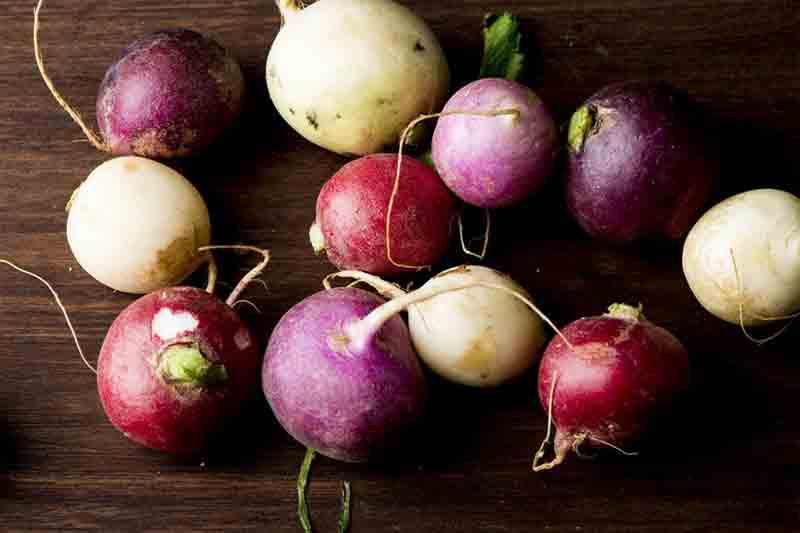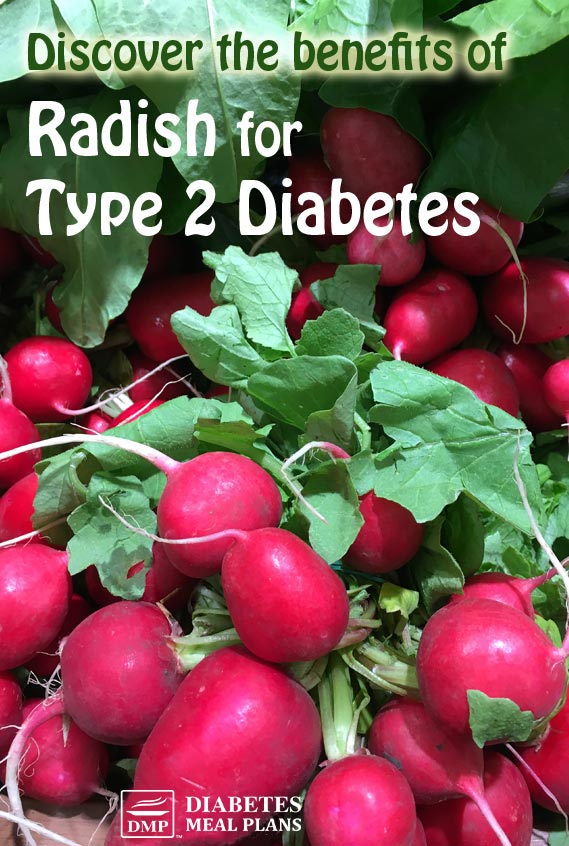Radish is often seen as a salad topper, but many people don’t realize just how healthy this spicy, crunchy veggie actually is.
Radish is a root vegetable that belongs to the same family as other uber-nutritious plants like kale and broccoli, and it’s a great source of tons of essential nutrients.
Being part of the same family as broccoli and kale makes radish a cruciferous vegetable. In terms of nutrition, all radishes are alike. But in terms of appearance this is not the case — there are various common radish varieties including white icicle, daikon, sparkler, cherry belle, white beauty, French breakfast, early scarlet gold and fire and ice.

which means it brings a whole other set of benefits with it, too. Let’s talk more about how radish can play a shining role in a healthy diabetes diet…
Radish Nutrition Facts
- Radish is super low in calories and carbohydrates – one cup contains just 19 calories and 4 grams of carbs!
- It’s a high fiber food, providing 2 grams of fiber per cup.
- It’s a fantastic source of antioxidant vitamin C – one cup will give you 29% of your recommended daily amount (RDA).
- It’s also a good source of folate, riboflavin, potassium, vitamin B6, manganese, magnesium, and calcium.
- Radish has a low glycemic index of just 32.
Health Benefits of Radish
Vitamin C: Fortifies the immune system, lowers blood pressure, helps wounds heal and prevents scurvy.
Calcium: For strong healthy bones and may help regulate glucose metabolism.
Fiber: Helps control blood sugar levels, promotes good gut bacteria, helps reduce cholesterol, and keeps your digestive function and metabolism in tip-top shape.
Vitamin B6: Helps the body make mood-regulating hormones, regulates sleep and may help control blood sugar.
Potassium: Acts as a counter balance to sodium and may help lower blood pressure.
Research on Radish
Radish leaves have been shown in animal studies to reduce hypertension, partly by increasing antioxidant levels.
Radish may prevent the development of diabetes and serve as a blood glucose-lowering agent for those who already have it!
Radish has also been found to improve lipid metabolism, decrease blood glucose, and suppress insulin secretion in both normal and diabetic animals.
Because of radishes’ antioxidant and anti-inflammatory properties, they can improve intestinal inflammation and decrease oxidative damage. This means that they could be particularly helpful for people who suffer from intestinal conditions like ulcerative colitis or IBS.
Radishes contain sulforaphane, a compound (also found in other cruciferous veggies like broccoli) that may protect the liver against oxidative stress.
Finally, black radish juice is known to decrease cholesterol and dissolve gallstones. It also contains compounds called glucosinolates, which have antioxidant properties and can directly reduce liver cholesterol levels.
Points for Consideration
If you have hypothyroidism or Hashimoto’s disease, keep your radish intake relatively low or consult your doctor before consuming large amounts. This is because radish contains compounds known to decrease thyroid activity.

Radish in the Kitchen
Selection
Choose bright-colored, smooth-skinned radishes that are moderately large. The stems should be green and crisp-looking.
Storage
Radishes can be kept in a plastic bag in the refrigerator for around one week. Make sure to remove their green stems before storage. They can also be frozen, but make sure to cut them into small pieces before doing so.
Uses
If you want to get your radishes tasting super crisp, soak them for a few hours in ice-cold water. Wash them, then chop off the green stems. From here, you can leave them whole, half them, or dice them up small.
Radishes add a fantastic crunch and peppery tang to any salad. They can also be fermented and made into kimchi, or served atop soup or alongside any protein-rich dish.
Cooking
Radishes can be roasted in the oven. Simply drizzle them with a bit of olive oil, place them on a baking sheet, and roast at 425°F/ 220°C for 20-25 minutes.
They also taste great stir fried in some coconut oil. Or simply try serving them alongside other veggies and proteins – meat, chicken, or fish.
Cutting Techniques
Slice off the green leaves on top of the radishes, and remove any root that is present.
So there you have it, enjoy your spicy slices of radishes for both their taste and all the nutritious benefits they have to offer.
Please pin, tweet or share this info to help others. Thanks!

Leave a Reply